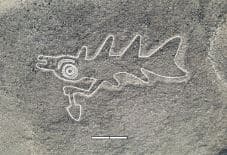More than 300 new geoglyphs have been discovered in the Nazca desert. Nazca is an arid plateau 500 kilometres south of Lima, Peru that is famous for the giant Nazca lines. One of Peru’s major tourist attractions is to take a light-plane flight over the lines.
The newly discovered glyphs, smaller, older and more weathered than the famous Nazca lines, were discovered by AI analysis of sweeping aerial photography from a portion of the 60 kilometre long Nazca plateau. After AI detection of a location of interest, researchers travelled in and surveyed the sites on foot. The researchers were working at the University of Yamagata’s Nazca Institute. Study publication and images of some of the glyphs available here.

The newly discovered glyphs are described by the researchers as “relief-type”, as opposed to the more easily visible and more well-known “line-type” glyphs. They average 9 metres in size, in contrast to the already known Nazca Lines that average 90 metres in size.

In the time of the Nazca culture, these smaller glyphs would mostly have been visible only from trails. Some would only become visible after walking from a trail to the closest glyph, from which a traveller could proceed on to the next one. This leads to the hypothesis that they served as waypoints in the desert.
The more famous lines, by contrast, were visible from properly constructed roads, which led between the Nazca’s culture’s Cahuachi ceremonial complex and the confluence of two rivers on the other side of the Nazca plateau.
As the relief glyphs are older, being made from around 100BC to 650AD, it’s possible they were a technique that evolved gradually among regular folks making their way across the desert. The Cahuachi-based priest-temple complex, which peaked around 500AD, may have later appropriated the folk concept in building the giant line-type glyphs. These definitely had ceremonial significance; for example, some lines converge at the point of sunset on the horizon at the winter solstice.
It makes for a fascinating look into indigenous knowledge in South America. The researchers commented that there are likely to be another 200-300 glyphs that will be revealed by further AI-enhanced analysis of the Nazca region.
Sign Up To Our Free Newsletter